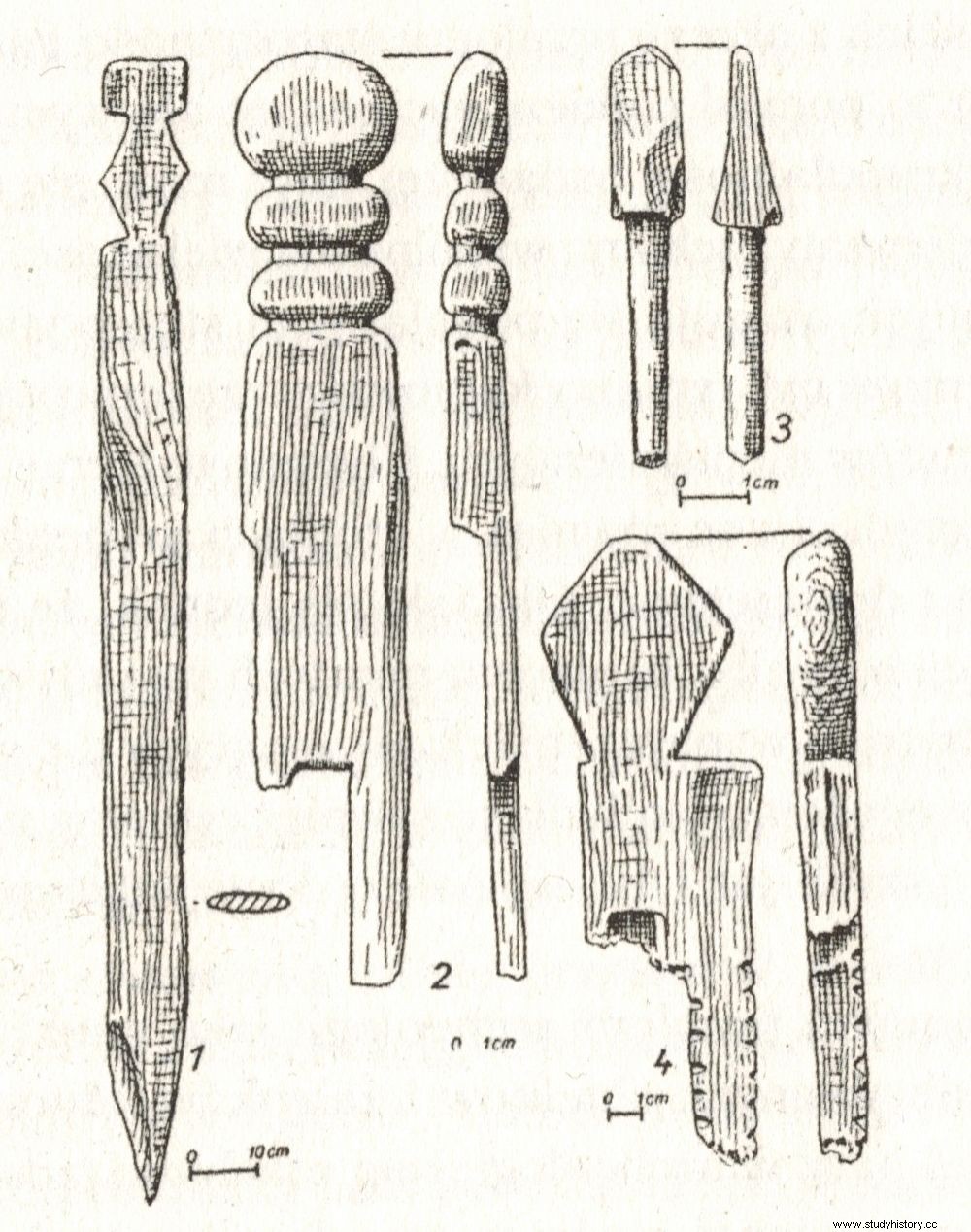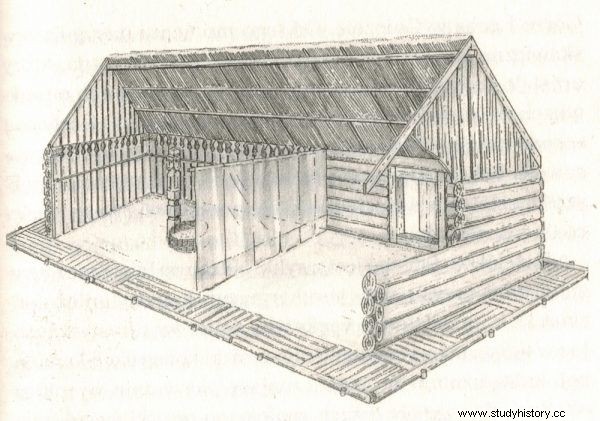This theory, although formulated almost two decades ago, still fires the imagination. According to the respected archaeologist, 70 years after being baptized by Mieszko, the inhabitants of Wrocław rejected Christianity and built a magnificent temple in honor of the old gods. Was this really the case?
Excavations in Ostrów Tumski in Wrocław were carried out at the turn of the 1950s and 1960s. It was then that the relics of a mysterious building from the times of the first Piasts were discovered.
The building was less than eight meters long and almost four meters wide. It was distinguished by its size and design. During its construction, rails were used, i.e. boards obtained as a result of splitting, not cutting the trunk. Moreover, it had two rooms, not one, as in typical houses of this era. Inside, remains of silk fabrics and goldheads were found. All this prompted the discoverer of the structure, Elżbieta Ostrowska, to say that it had a "special function".
In the middle of the last century, little else could be said. The building was largely forgotten until the turn of the century. It was then that one of the boards found in it was re-examined using the dendrochronological method - an extremely precise and only recently popular method of dating based on wood rings.
An innovative technique has shown that the fence was cut at the turn of 1032 and 1033. And thus:that it was most likely then that a "special" building was erected.
Trace of the rebellion and the faith of the ancestors
Sławomir Moździoch, one of the most influential Silesian archaeologists, proposed a truly revolutionary theory based on the new dating. He stated that the mysterious structure was in fact a pagan temple.

Decorative elements from an alleged temple in Wrocław.
It was to be built in the years of the so-called "reaction", i.e. a massive rebellion against the Church and the authorities, known from written sources. This rebellion, based on the work of the Czech chronicler Cosmas and on the Ruthenian Tale of Bygone Years many researchers are located just around the year 1032.
Apart from the coincidence of dates, prof. Moździoch drew attention to luxurious fabrics:he considered them "the remains of the curtains separating the sacred space from the vestibule". He associated Dranice with the pagan temple in Gross Raden in Mecklenburg, discovered in the 1970s and considered a flagship example of Slavic religious architecture. There, a similar construction element was used, so the carved dranice began to be treated as a specific determinant of cult buildings.
Moreover, the scientist mentioned the plant casualties that were noticed during excavations conducted sixty years ago. "Near the foundation beam, in the south-west corner, a horse's skull was found" - explained Prof. Moździoch in one of his works. In turn, under the south-west corner and in the center of the south wall, under the foundation, the builders placed vessels, probably containing "magical" sacrifices.
All these arguments, but especially the date obtained thanks to the new research, gave rise to the hypothesis. And then:with almost complete conviction. While in 2000 prof. Moździoch wrote about a certain concept, so after a few years he had no doubts that the building in Wrocław had to be a temple. From its existence, he drew far-reaching conclusions as to the political events of that epoch.
Other scholars followed him, and the pagan temple was established in scientific works for good. Not necessarily right.
Doubtful analogies, uncertain dates
For several years, the interpretation of the building as a temple has been questioned by another influential researcher, Dr. Dariusz A. Sikorski from Poznań. He does not even mean to refute the theory, but to point out that it has a weak foundation, and that many of the author's arguments can be easily undermined. Thus, scientific honesty requires caution, skepticism and… proposing other solutions.
The date of the pagan reaction cannot determine the function of the building, because it is not universally accepted, nor even the fact of the outbreak of anti-Christian disturbances is not certain. In recent years, there have been voices indicating that the "reaction" was more anti-state than anti-religious. And that if it was aimed at representatives of the Church, it was mainly because they were considered to be representatives of the prince.

Alleged pagan temple in Wrocław, reconstructed by Stanisław Moździoch.
The analogy with Gross Raden must also raise doubts. This temple became a symbol, mainly because it was reconstructed, it was a tourist attraction, and the press was eager to reproduce its drawings. The scientific community is not at all certain, however, that in Gross Raden… there was a temple at all.
The discoverer of the object, Ewald Schuldt, deliberately hindered access to the research results, its reconstruction was largely based on fantasy, and in his hypotheses he was wrong by over a hundred years. He claimed that the temple was built in the mid-ninth century. Today it is already known that the building was dated only from the end of the 10th century. And that it was considered a sacred object mainly because of its "atypicality" and not for any hard evidence.
Many researchers have expressed and voiced opinions that "the monuments accompanying the object [in Gross Raden] and their arrangement testify rather to the secular purpose of the building". And if Gross Raden was not necessarily a temple, it is difficult to consider a building from Wrocław as it, just because it is a bit similar ...
If not a temple then what?
Dariusz A. Sikorski has already expressed his objections on the pages of several scientific papers. Now even the average history buff can see them.
Wydawnictwo Poznańskie has published a popular science book "Religions of ancient Slavs" . On its pages, the author proposed an alternative explanation of the role of the Wrocław building. Admittedly unconfirmed, but also - no less probable than the temple hypothesis. As Dariusz Sikorski writes:
None of the arguments in isolation or all of them together are sufficient to make this building a temple of the pagan Slavs . Its features can be explained without reference to the alleged sacred function. If we assume that the building was the seat of a local leader who, after the collapse of the central Piast authorities, carved a piece of it for himself, he might want to mark his own position with a different, more decorated building.
The richer equipment in the "prince" seat is also not surprising. Although the building differs from other residential houses, there are traces of use that are alien to the descriptions of pre-Christian Slavic temples known to us, e.g. the remains of the hearth in the corner of the room referred to as the vestibule. On the other hand, the remains of the in-house sacrifice and magical practices are also found in objects that certainly did not have a temple function.
So as we can see, the proposed temple interpretation of the building is not obvious.
